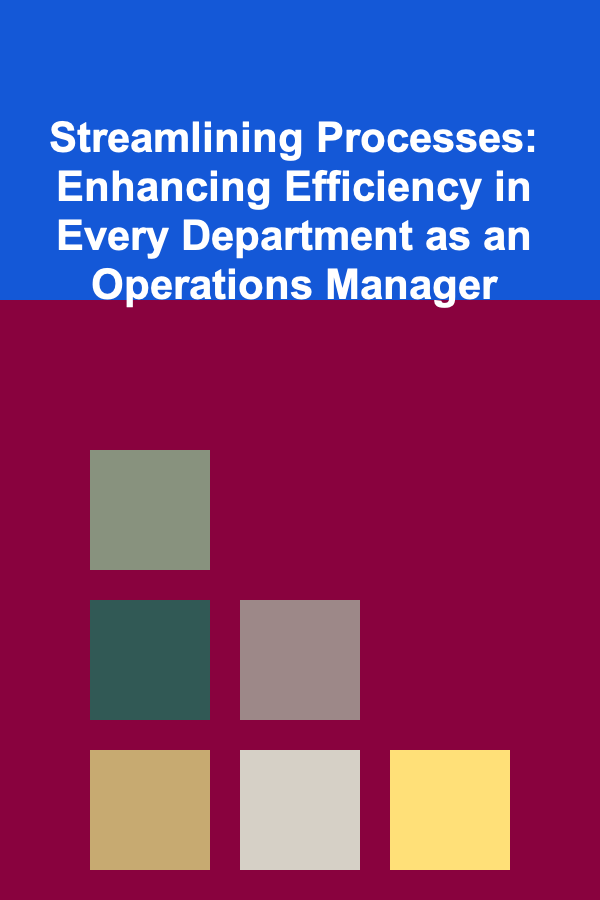
How to Set Up a Home Budget That Accounts for Unexpected Expenses
ebook include PDF & Audio bundle (Micro Guide)
$12.99$9.99
Limited Time Offer! Order within the next:

Managing a household budget can feel like a balancing act between maintaining financial stability and being prepared for life's surprises. Unexpected expenses, whether they come in the form of car repairs, medical bills, or home maintenance emergencies, have the potential to derail even the most well-planned budget. That's why it's essential to set up a home budget that accounts for these unpredictable financial events while still allowing for day-to-day living.
In this article, we'll delve deep into the principles and practices that will help you create a budget that is both flexible and resilient in the face of unforeseen expenses. We'll cover everything from understanding your basic financial situation to establishing emergency savings and rethinking discretionary spending. By the end of this article, you'll have a comprehensive roadmap for setting up a budget that prepares you for life's uncertainties while maintaining your financial well-being.
Understanding Your Current Financial Situation
Before you can set up a budget that accommodates unexpected expenses, you need to have a clear picture of your current financial situation. This includes understanding your income, regular expenses, savings, and existing debts. This step will provide you with the foundation for building a well-rounded budget that balances stability with flexibility.
1. Track Your Income
Your income is the cornerstone of your budget, as it dictates how much you have available to cover both fixed and variable expenses. Start by tracking all your sources of income, including:
- Primary income: This is your main paycheck, whether from your full-time job, freelance work, or a business you own.
- Secondary income: If you have any additional income streams (e.g., side jobs, passive income, or rental income), make sure to factor them in.
- Irregular income: Some people may receive one-time or irregular payments, like bonuses, tax refunds, or occasional gigs. Estimate how much of this income you can expect over the year.
Once you have a clear understanding of your monthly income, subtract any taxes, insurance premiums, or automatic deductions (e.g., retirement contributions, student loans, etc.) to get a realistic view of your take-home pay. This gives you the amount of money you have to work with when creating your budget.
2. List Your Fixed and Variable Expenses
The next step in setting up your budget is understanding both your fixed and variable expenses. Fixed expenses are costs that remain constant each month, such as rent or mortgage payments, car payments, and insurance premiums. These expenses are non-negotiable and should be prioritized in your budget.
On the other hand, variable expenses can change from month to month. These might include:
- Utilities: Electricity, water, gas, and internet bills
- Groceries: The cost of food, cleaning supplies, and household products
- Transportation: Gas, public transportation fares, or vehicle maintenance
- Entertainment and leisure: Dining out, streaming services, hobbies, etc.
Once you have listed both types of expenses, calculate their total to see how much of your income is already committed to necessary monthly spending.
3. Assess Your Savings and Debts
Understanding your current savings and any outstanding debts is also crucial in determining how much room you have in your budget for unexpected expenses. Consider the following:
- Emergency fund: Do you already have an emergency fund in place? An emergency fund is a critical element of a budget that accounts for the unexpected, so having at least 3-6 months' worth of living expenses saved up can provide financial peace of mind.
- Debt obligations: Review your credit card balances, loans, and other debts. Are you making minimum payments, or can you allocate more to pay off high-interest debt faster?
- Long-term savings: Don't forget to account for your retirement savings, college funds, or other long-term financial goals.
These factors will play a significant role in shaping your overall budget and determining how much you can comfortably allocate toward emergency preparedness.
Building a Budget That Accounts for Unexpected Expenses
Now that you have a clear picture of your financial situation, it's time to build a budget that accounts for both your regular expenses and those unexpected costs that can crop up at any time.
1. Create a Flexible Budget Framework
While it's important to plan for your regular, recurring expenses, a well-designed home budget should be flexible enough to absorb unexpected costs. Consider using the 50/30/20 rule as a guideline:
- 50% of your income: This should go toward essential needs, such as housing, utilities, food, transportation, and insurance.
- 30% of your income: This is allocated to discretionary spending, including entertainment, dining, hobbies, and non-essential items.
- 20% of your income: This portion should be directed toward savings and debt repayment. If you don't yet have an emergency fund, prioritize this savings category until you have at least 3-6 months of expenses saved up.
A flexible budget is key when it comes to managing unexpected expenses, as it allows for adjustments to be made based on the needs of each month. For example, if you need to allocate more money toward your emergency savings in one month, you can cut back on discretionary spending like entertainment or dining out.
2. Build an Emergency Fund
An emergency fund is the foundation of a budget that accounts for unexpected expenses. It serves as a safety net to cover unforeseen costs like medical bills, car repairs, or home maintenance emergencies.
Experts recommend saving at least 3 to 6 months of living expenses in an easily accessible account. This will provide you with the cushion you need to weather any financial storms that come your way. The best way to build your emergency fund is to treat it like a fixed expense in your budget.
- Start small: If you can't immediately save 3-6 months' worth of expenses, start by aiming for $500 or $1,000, which can cover many smaller emergencies.
- Automate savings: Set up automatic transfers to a separate savings account dedicated solely to your emergency fund. Even small, consistent deposits will help your fund grow over time.
- Replenish after use: If you need to dip into your emergency fund, make it a priority to rebuild it as soon as possible.
By building this safety net, you ensure that you don't have to rely on credit cards or loans to cover unexpected costs, which can lead to even greater financial strain.
3. Prioritize Essential and Unpredictable Costs
Certain unexpected expenses, like car repairs or home appliance breakdowns, are more common than others. These costs can be predicted to some degree, even if the exact timing is uncertain. When setting up your budget, it's essential to prioritize funds for these types of potential expenses. Here's how you can do it:
- Home and car maintenance: Both of these areas tend to require occasional repairs or upgrades. Whether it's routine maintenance (like oil changes) or emergency repairs (such as fixing a leaky roof), budgeting for these costs can help alleviate the stress when something breaks down.
- Healthcare and insurance: Medical bills are another unpredictable but common expense. Even with insurance, out-of-pocket costs for prescriptions, copays, and medical visits can add up. It's important to budget for these costs and, if possible, take advantage of health savings accounts (HSAs) or flexible spending accounts (FSAs) to set aside money for health-related expenses.
- Pet-related expenses: If you have pets, don't forget to account for their needs. Unexpected veterinary bills or the cost of pet care can arise, and they can be significant, especially in the case of an emergency.
To handle these costs effectively, consider setting aside a separate sinking fund for each category (e.g., car repairs, home repairs, healthcare) to ensure that you are financially prepared when something unexpected arises.
4. Reevaluate and Adjust Regularly
Budgets are not set in stone. Life changes, and your financial situation will likely evolve over time. Whether it's an increase in income, a change in living expenses, or the need to adjust your emergency fund, regularly revisiting your budget is essential for staying on track.
Consider reviewing your budget on a monthly or quarterly basis to account for any new or unexpected expenses that may have come up. As your financial situation improves, you may find that you can allocate more money to savings or pay off debt more quickly.
Tips for Minimizing the Impact of Unexpected Expenses
While it's impossible to predict every unexpected expense, there are steps you can take to minimize their impact on your budget and finances:
- Maintain regular maintenance: Keeping up with routine maintenance on your home, car, and health can prevent larger, unexpected bills in the future. Regular check-ups, inspections, and repairs can catch small problems before they become major financial burdens.
- Build financial flexibility: If possible, try to structure your budget so that you have some degree of flexibility. Whether it's cutting back on non-essential spending or temporarily reducing your savings contributions, having options can help you manage unexpected expenses without disrupting your entire financial plan.
- Use credit cautiously: Credit cards can be useful for emergencies, but they should be used cautiously. If you must rely on credit to cover unexpected costs, make sure you can pay off the balance quickly to avoid accruing high-interest charges.
Conclusion
Setting up a home budget that accounts for unexpected expenses is crucial for maintaining financial stability and reducing stress during difficult times. By tracking your income, expenses, and savings, and building a flexible budget with room for unexpected costs, you can prepare yourself for life's uncertainties. Whether it's by establishing an emergency fund, prioritizing essential expenses, or rethinking your discretionary spending, the key to a successful home budget is planning for the unexpected.
By taking proactive steps and adjusting your budget regularly, you can ensure that your financial house remains secure---no matter what surprises life throws your way.

Effective Strategies for Legal Secretaries: Streamlining Legal Processes and Communication
Read More
How to Clean Your Fireplace and Maintain It Properly
Read More
How to Prevent Burglary Using Neighborhood Watch Programs
Read More
Streamlining Processes: Enhancing Efficiency in Every Department as an Operations Manager
Read More
How To Discover Novels Based on True Events
Read More
How to Create a Financial Planning Checklist for Freelancers
Read MoreOther Products

Effective Strategies for Legal Secretaries: Streamlining Legal Processes and Communication
Read More
How to Clean Your Fireplace and Maintain It Properly
Read More
How to Prevent Burglary Using Neighborhood Watch Programs
Read More
Streamlining Processes: Enhancing Efficiency in Every Department as an Operations Manager
Read More
How To Discover Novels Based on True Events
Read More